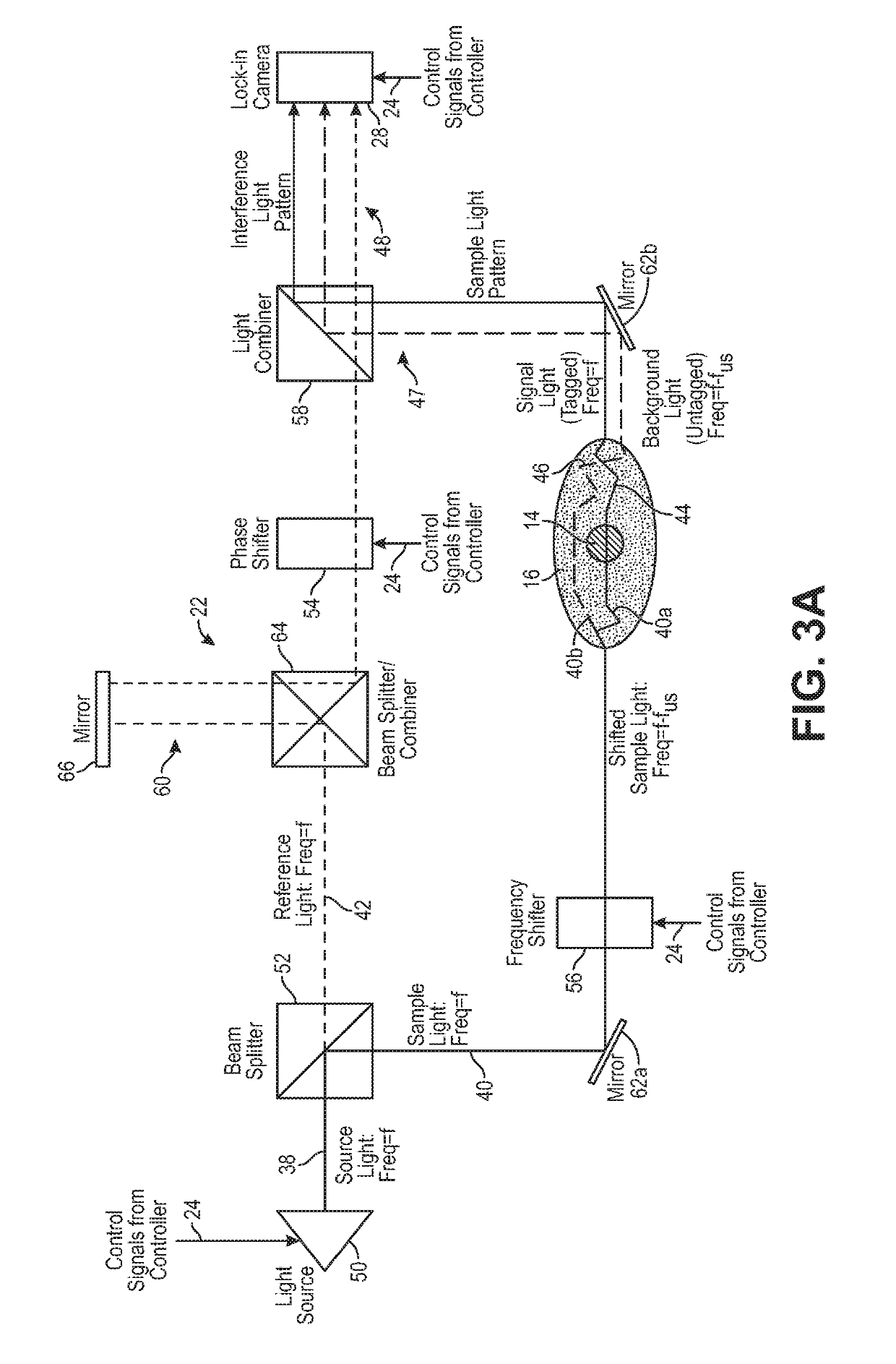Because DOT and fNIRS rely on light, which scatters many times inside brain,
skull, dura, pia, and
skin tissues, the light paths occurring in these techniques comprise random or “diffusive” walks, and therefore, only limited spatial resolution can be obtained by a conventional
optical detector, often on the order of centimeters.
The reason for this limited spatial resolution is that the paths of photons striking the
detector in such schemes are highly variable and difficult, and even impossible to predict without detailed microscopic knowledge of the scattering characteristics of the brain
volume of interest, which is typically unavailable in practice (i.e., in the setting of non-invasive measurements through
skull for brain imaging and brain
interfacing).
Typical UOT implementations generate weak signals that make it difficult to differentiate ultrasound-tagged light passing through the focal voxel from a much larger amount of unmodulated light which is measured as DC
shot noise.
Thus, conventional UOT has the challenge of obtaining optical information through several centimeters of
biological tissue, for example, noninvasive measurements through the
human skull used to measure functional changes in the brain.
One technique uses a narrow spectral filter to separate out the untagged light striking a single-
pixel detector, and is immune to “speckle
decorrelation” (greater than ˜0.1 ms-1 ms) due to the scatterers' motion (for example,
blood flow) inside living
biological tissue, but requires bulky and expensive equipment.
However, the conventional CCD cameras used for
heterodyne PSD have low frame rates, and therefore suffer from a relatively
low speed relative to the speckle
decorrelation time, thereby making this set up insufficient for
in vivo deep tissue applications.
Thus, only a few bits of a pixel value can be used to represent the useful AC signal, while most of the bits are wasted in representing the DC background, resulting in a low efficiency in the use of bits.
Besides the challenges posed by the signal-to-
noise ratio, speckle decorrelation time, and efficient pixel bit
processing, another challenge involves obtaining sufficient axial resolution (i.e., the depth resolution or ultrasound propagation direction).
Although PW UOT improves axial resolution, the pulsed UOT signals are weak relative to continuous UOT signals.
The use of lock-in cameras for measurement and
demodulation of modulated light fields has, however, a number of disadvantages, particularly in the context of rapid measurement signals from dynamic, strongly scattering biological tissues.
Second, lock-in cameras have only achieved limited scale to date, e.g., less than 100,000 pixels (e.g., the Heliotis Helicam C3), and do not have the large industrial support base of the conventional camera industry (e.g., with a
digital camera that is now included within every
smart phone).
Third, lock-in cameras support only a limited number of
data storing “bins” per pixel (currently, four bins per pixel) due to limitations on pixel area and
photodetector fill factor, and thus, support only a limited number of temporal samples in the lock-in detection process.
The first of these disadvantages, in particular the
limited sampling speed, poses a key challenge for the use of lock-in cameras to support imaging deep inside dynamic, highly scattering biological tissues, such as the
human skull and brain.
This poses an obstacle for lock-in camera based detection, since the speed of lock-in cameras is limited.
However, for example, in some applications with specific requirements in power and
wavelength, the maximum width of optical pulses generated by readily available pulsed lasers is limited; for example, the maximum pulse width of conventional off-the-shelf pulsed lasers is currently 200 ns, thereby requiring a
pulsed laser to be customized, and increasing the cost and complexity of the UOT
system.
Thus, although the UOT schemes described above may be sufficient for certain applications, particularly when using lock-in cameras, such UOT schemes are inappropriate for the application of 3D-resolved,
highly sensitive detection of small signals (e.g., blood-
oxygen-level dependent signals) non-invasively through thick scattering
layers, such as the
human skull.
 Login to View More
Login to View More  Login to View More
Login to View More 


